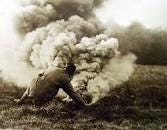The Horrors of World War I: How Chemical Weapons Changed History According to Historians
Around 100,000 people died as a result of the use of chemical weapons during the First World War
By subscribing to my blog newsletter, you will support my efforts to ensure food and medical care to a few lonely living old people and stray animals in Bulgaria. I created this blog for fundraising purposes. Any subscription guarantees 3-5 weekly dispatches via e-mail with new content and full access to all the publications in the blog for $6 a month or $60 per annum. Thank you.
On the eve of the 20th century, the world powers were very worried that the use of chemical weapons would become an integral part of any future-armed conflicts. For this reason, in 1899 they signed an agreement prohibiting the use of projectiles containing poisonous substances. However, it was violated only a few years later, after the outbreak of the First World War. The first to do this were the French, which used tear gas, causing a strong burning sensation in the eyes, mouth and nose. A few months later, the Germans decided to develop their own chemical weapons. The task was undertaken by Fritz Haber, who in 1918 received the Nobel Prize for Chemistry.
Keep reading with a 7-day free trial
Subscribe to Nicola’s Substack to keep reading this post and get 7 days of free access to the full post archives.




